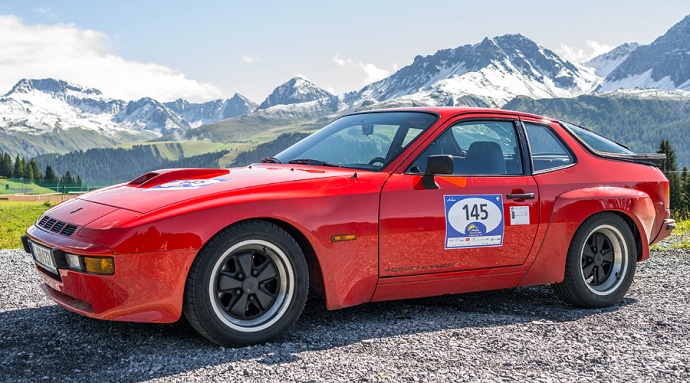Porsche 924 Carrera GT Was a Powerful Suprise
If the best classic cars have great looks, are great to drive and are exotically rare, then the Porsche 924 Carrera GT is up there with the best of all classic cars. The 924 Carrera GT had supercar looks, sounds and scats like a Carrera too.
Had anyone else built the 924 it probably would have been hailed as a brilliant little sports car. It was strong, remarkably efficient and deceptively quick, making the most of its rather modest two-litre engine but in the opinion of Porsche fans it was thought to be a bit timid. Then the incredible 924 Carrera GT appeared, setting the critics back in their seats. Not only was the 924 Carrera GT stunningly quick, it had style and street fighter aggression.
Of the 406 units built 200 are earmarked for Germany and 75 for the UK, which was about the only place you could still get full value from a Carrera. A speed of 130 mph at the 6400 rpm rev limiter then, you shift into 5th, and 150 mph is well in sight. This is a true 150 mph automobile which will accelerate from zero to 60 in less than seven seconds, despite a turbo that doesn’t really go to work until 3000, coupled to typical Carrera gearing not designed for drag racing.
it is not enough then as it is now simply to make a powerful monster; fuel consumption figures were noticed then as well. Porsche fitted a digital ignition control to keep the engine at max efficiency, and improved aerodynamics. With and eye for detail work on the body keeps, the GT is the same as the Carrera’s plain cousin, despite wide fenders, extra scoops a larger rear spoiler lip helps considerably. In a combined European consumption test, readings were taken at a steady 55 and 75 mph and averages those figures with a city reading, the Carrera GT received a rating of 25.8 mpg against 26.1 for an unblown European 924!
The hood scoop was the first indication of a surprise in the engine compartment that contained a new configuration. Compression is raised on number to 8.5:1, and the scoop leaded to a flat intercooler, The engine reaches is 210 horsepower potential at 6000 rpm. The power-plant is coupled to a heavy shifting five-speed, with top four in an “H” and fifth place in a dogleg to the left rear. Gear speeds are 35-65-100-130 and beyond.
The ride is firm to the point of bounce on the rougher surfaces,but if you let it seek out its own path, it can be blindingly fast and a ball to drive. 215/60 tires help with stability, and even lower section 55/50 series tires are optional. Fender flares were made of the same bounce-back material as a 928 nose, warding off small blows. The 924 Carrera GT was available in black or Guards Red, with “Carrera” embossed on the front right wing.
Inside the Carrera, there is luxury despite the car’s competition character, Electric windows and mirrors, a removable roof panel and pinstripe seat go with air conditioning and full radio/tape setup.
Very few will have the experience, but any old Porsche fan who gets hands on the Carrera GT and an empty road has gotta agree that Porsche got the 924 right this time around.
Group 4 924 on the racing circuit
On the racing circuit, although the 911 based Porsche racer still is king, the Porsche factory banked heavily on making the 924 a truly competitive machine. The 924 Group 4 racer epitomizes the intensive effort put into a car before it ever sees a race track. This car went through wind tunnel experiments, 600 mile washboard runs, 24 hour tests around Weissach, 30 hour sessions on the test bed, electro-pulsator test, 24 hour testing at Paul Ricard, rain tests at Weissach and even endurance testing on the chassis dynamo-meter.
In the 924’s initial trial at Le Mans 1980, all three teams cars finished the race , taking 6th, 12th and 13th places. The reactions from the drivers were extremely positive, particularly how well the cars handled in the rain.
The car employs a lightweight fiberglass hood, fender flares and rear windows. A front air dam and rear spoiler have also been fitted. The body has been lightened, unitized and reinforced with a welded in roll-cage. The 375 horsepower engine is basically an intercooled turbocharged version of the 924’s D Production motor. The fuel injection featured a boost enrichment sensor which enriches the mixture at the top end, but keeps it from running too rich at the bottom end. The overall weight of the car, race ready, is 2079 pounds. Four wheel vented disc brakes, using the biggest 13 inch rotors and long distance calipers, are fitted, as are 917style axles. The gearbox is a Porsche five speed unit utilizing 935 type synchronizers and a locked differential. BBS wheel and Bilstein gas pressure shock absorbers are used all around.
The 924 Turbos showed excellent speed capabilities, but as in any new race effort, small problems crop up to prevent a car’ true potential from showing. The 924’s had a long way to go in trying to eclipse the hold the 935 had on IMSA racing. They were competing in the GTO division of IMSA, running against the likes of BMW M-1 and Datsun ZX Turbos, and being driven by such names as Al Holbert, Doc Bundy, Rick Mears and Jonny Rutherford.
924 CARRERA GT was a powerful surprise!
